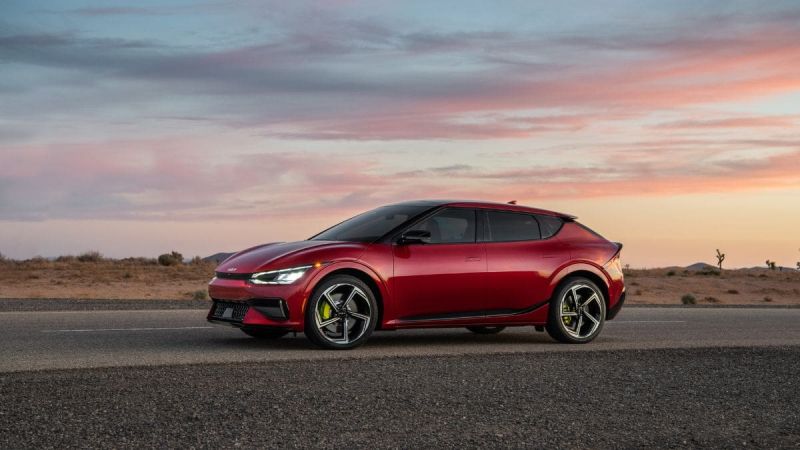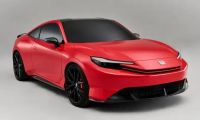The Kia EV6 debuted last year in the US to much promise and to rave reviews by the press, myself included. Its sales for the first 4 months in the US seemed promising, too. But were those just the months spent satisfying the preorder queue? Possibly, but it felt like the reason EV6 sales began to slow down after that was simply because Kia couldn’t deliver enough product, this amid stories about ongoing supply chain issues that persisted throughout the middle of last year. And now, Kia is of course trying to ramp up production of its plug-in vehicles and batteries may still be in somewhat short supply. But is that really the main reason EV6 sales are languishing in the 650 - 1,300 units per month range since October of last year? Maybe, or maybe not.
The EV6 went on sale in the US in February of last year, so we basically have a full year of sales data on it now. From February last year through February of this year, Kia sold 22,902 EV6s according to Kia’s monthly US sales figures. That isn’t quite a compliance car sales figure, but it isn’t that far off. For comparison, the Chevy Spark EV, which only sold and or leased 7,371 units during the 5 years it was available as a new vehicle is a much better example of a compliance car. Its best year was 2016 (it’s final model year) when it moved 3,035 units. So roughly speaking, the EV6 outsold the Spark EV compliance car by about 7:1 in its best year. However, Kia’s US EV6 sales have mostly trended downward since July of 2022. I propose that starting in summer of last year, and especially after the Inflation Reduction Act (IRA) was passed in the US, the main reasons for Kia’s gradual decline are primarily due to the following 3 factors: First, the loss (temporary or otherwise) of the federal tax credit and Kia’s shifting of their EVs toward European markets (about 12% more EV6 went to Europe vs. US in that timeframe). Second, increasing interest rates have hurt affordability. Third, Kia gained a particularly negative reputation for charging the highest market adjustments of all brands on their new vehicles due to the greed of a significant number of its dealers. Combined, these three factors are, in my opinion, the primary reasons Kia’s sales are down. That isn’t to say that Kia would be selling far more EV6’s if these things weren’t true, because they are still constrained by battery and or other component supply. What I mean is that these 3 factors are dragging their sales down more significantly and causing what inventory Kia does supply the US with to sit on lots for longer periods of time.
I don’t think the EV6 is in danger of being withdrawn from the US market any time soon since Kia is invested in growing its EV market share as quickly as possible. However, Kia is seriously struggling to sell what is otherwise one of the most popular and desirable EVs on the market today (as evidenced by the many accolades the EV6 has achieved contrasted against their wilting sales). If Kia wants to grow its US sales of the EV6 much beyond its recent monthly run rates, they will have to consider cutting prices/offering more incentives in the short term, and or moving production and materials sourcing to the US (which would reinstate the EV6’s eligibility for federal incentives). Unless Kia is changing its mind about longer term electrification goals for the US, they will need to do something like what I have proposed in order to turn their mediocre sales numbers around. Longer term, they could also invest in manufacturing efficiency, streamlining of model lines, and other logistical or production line changes to bring costs down too, of course. Should Kia not take some bold steps, I predict next year’s US EV6 sales will be down 20-40% over the previous year. It actually seems like Kia is setting up the EV6 for more “cannibalization” of sales due the pricing structures of their Niro EV and forthcoming EV9 (in that their prices are close/overlap). If that happens, at that point the EV6 would enter the compliance car “zone” and that could be the beginning of the end for all-star newcomer. I hope that Kia will prove me wrong.
What do you think, readers? Is the EV6 looking like it's in trouble? Do you think Kia will turn their sales declines around somehow? Please leave any thoughts or questions below.
Image provided by Kia.
Justin Hart has owned and driven electric vehicles for over 15 years, including a first generation Nissan LEAF, second generation Chevy Volt, Tesla Model 3, an electric bicycle and most recently a Kia Sorento PHEV. He is also an avid SUP rider, poet, photographer and wine lover. He enjoys taking long EV and PHEV road trips to beautiful and serene places with the people he loves. Follow Justin on Twitter for daily KIA EV news coverage.












Comments
I wanted the Kia ev6 GT (576
Permalink
I wanted the Kia ev6 GT (576 hp version) but it would cost $70,000.00 out the door for a KIA that gets 200 miles of range, has no IRS tax incentive and doesn't even come with a charger!!! So I would pay well over $1000.00 per month....FIR A KIA........
LOL, NOPE
Yours is a completely
Permalink
In reply to I wanted the Kia ev6 GT (576 by Jerry Moody (not verified)
Yours is a completely rational response to an inflated market price. I wonder if you might be able to get the IRA incentive if you could find a slightly better price and opted for the lease (not that I am suggesting you do that, just noting that at least some models of the EV6 are eligible for the incentive, if leased). In any case, if you feel the need for speed, perhaps a performance model of the Tesla Model Y or 3, or the Mustang Mach-E could suffice for a little less?